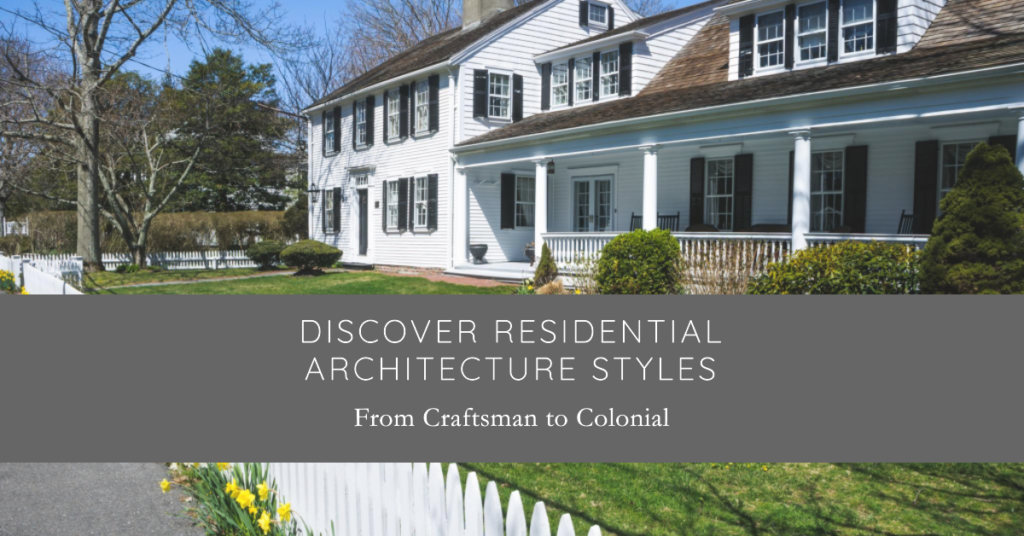
Table of Contents
Introduction: Embracing Architectural Diversity
Residential architecture serves as a timeless reflection of cultural heritage, artistic expression, and functional design. From the rustic charm of Craftsman homes to the dignified symmetry of Colonial residences, each architectural style encapsulates a unique narrative of history and craftsmanship. In this comprehensive exploration, we embark on a captivating journey through the diverse landscape of residential architecture, delving into the distinctive features, origins, and enduring appeal of styles ranging from Craftsman to Colonial.
Craftsman: A Testament to Artisanal Excellence
Craftsman architecture emerged in the early 20th century as a celebration of craftsmanship and simplicity in design. Characterized by low-pitched roofs, exposed rafters, and handcrafted details, Craftsman homes exude a warm and inviting ambiance. The emphasis on natural materials such as wood and stone reflects the movement’s commitment to harmonizing with the surrounding environment.
The interior spaces of Craftsman homes are often characterized by open floor plans, built-in cabinetry, and intricate woodwork, fostering a sense of organic unity and functionality. These homes prioritize comfort and livability, with cozy fireplaces and expansive porches inviting residents to embrace a relaxed lifestyle. Despite evolving trends in architecture, Craftsman homes continue to captivate homeowners with their timeless charm and enduring craftsmanship.
Colonial: Timeless Elegance and Symmetry
Colonial architecture traces its roots back to the 17th and 18th centuries when European settlers brought their architectural traditions to the New World. Inspired by classical Greek and Roman design principles, Colonial homes embody a sense of timeless elegance and symmetry. The hallmark features of Colonial architecture include symmetrical facades, evenly spaced windows, and central entryways adorned with pediments and columns.
The interior layout of Colonial homes typically follows a traditional floor plan, with formal living spaces on the first floor and private quarters on the upper levels. High ceilings, elaborate moldings, and refined detailing contribute to the grandeur and sophistication of Colonial interiors. Whether nestled in historic neighborhoods or newly constructed developments, Colonial homes continue to command admiration for their graceful proportions and enduring allure.


Transitioning Through Time: Evolution of Architectural Styles
As societal preferences and design trends have evolved over the centuries, residential architecture has undergone a remarkable transformation, reflecting shifting cultural values and technological advancements. From the ornate Victorian mansions of the 19th century to the sleek minimalism of contemporary design, each era has left its indelible mark on the architectural landscape.
The transition from one architectural style to another is often influenced by a myriad of factors, including technological innovations, economic prosperity, and cultural movements. For example, the rise of the Arts and Crafts movement in the late 19th century inspired a departure from ornate Victorian excess towards the simplicity and craftsmanship of Craftsman architecture. Similarly, the post-World War II era witnessed a surge in suburban development and the proliferation of Ranch-style homes, characterized by their single-story layouts and close connection to the outdoors.
Revival and Reinvention: Contemporary Interpretations of Classic Styles
While historical preservation efforts have ensured the survival of many architectural gems from the past, contemporary architects continue to draw inspiration from classic styles while infusing them with modern sensibilities. The revival of architectural styles such as Craftsman, Colonial, and Mediterranean reflects a desire to reconnect with the past while embracing the conveniences and aesthetics of contemporary living.
Contemporary interpretations of classic architectural styles often feature open-concept layouts, energy-efficient materials, and sustainable design principles. By blending timeless elegance with cutting-edge technology, architects strive to create homes that resonate with today’s homeowners while honoring the legacy of the past. Whether nestled in urban enclaves or rural retreats, these modern interpretations pay homage to the enduring appeal of historical architecture while embracing the demands of modern life.
Conclusion: Celebrating Architectural Diversity and Heritage (Residential Architecture)
In the tapestry of residential architecture, each style represents a chapter in the rich and diverse history of design and craftsmanship. From the humble simplicity of Craftsman homes to the stately elegance of Colonial residences, each architectural style tells a story of cultural heritage, artistic expression, and human ingenuity.
As we navigate the ever-changing landscape of architectural trends and preferences, it is essential to cherish and preserve the architectural treasures of the past while embracing the innovations of the future. By celebrating the diversity of architectural styles and honoring the legacy of craftsmanship, we ensure that future generations will continue to find inspiration and solace in the timeless beauty of home.


